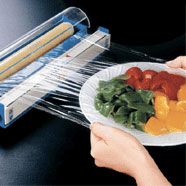 Plastic has revolutionized the way we move and store our food…
Plastic has revolutionized the way we move and store our food…
Its incredible properties have resulted in us being surrounded by plastic food packaging. Next time you are at the supermarket make a mental note of the package-free products – you will likely be able to count them on one hand. Certainly one of the greatest challenges we face in how to protect our environment is dealing with the mountains of plastic generated by our lifestyle of convenience and efficiency. However, an equally important challenge is how we safeguard our foods from chemical contamination by the very wrappers designed to protect and preserve them.
It is not simply manufacturers and retailers using these plastics; our beloved kitchens cupboards and drawers are often full of plastic containers, bags and cling film. We use it for storing food, wrapping meal extras and protecting our lunches for taking to work and school. It can seem like a daunting prospect living without things such as plastic cling film/wrap but believe me, once you make a few modifications you won’t look back- especially knowing just how toxic these plastics can be!
Various types of plastic are used for packaging foods such as polycarbonate, high and low density polyethylene, styrene, and polypropylene 2. A number of studies have demonstrated that the chemicals found in these packages may easily leach into food and beverage products1 , and that these include damaging phthalates, alkylphenols (APs), 2,2-bis(4- hydroxyphenyl)propane, (bisphenol A or BPA) and di(2-ethylhexyl) adipate (DEHA) 2. Plastic cling wrap which is often made from poly(vinyl chloride) or PVC, is so thin that it can allow almost complete migration of chemical substances into food 3.
I realise this is a little disconcerting but awareness is important and eneables us to help protect our families health.
Researchers in a study on food package toxicity note that many plasticizers and plastic additives are considered as Endocrine (Hormone) Distruptors, and can affect the reproductive system or demonstrate cancer-causing properties 2. They further state that DEHA, a plasticizer commonly added to cling wraps, has been shown to produce liver cancer in mice. BPA, which is used in many plastics and some cling wraps can lead to health problems even in low doses, including birth defects of the reproductive system in laboratory animals 5.
Certain factors such as temperature and type of food can affect the degree of chemical leaching2. Foods such as cheese and meat are particularly prone, both because of their high fat and oil content which encourage chemicals to leach, and because of their wide surface area being largely in contact with wrapping 4.
Irradiation of foods can additionally increase the leaching of these harmful chemicals. Foods that are irradiated for preservation (which may include poultry, meat, fruits and vegetables) are usually pre-packaged, and depending on the packaging used and the irradiation conditions, can lead to free radicals, hydroperoxides, and carboxylic acids being produced 1.
Knowing that these plastic packaging’s can have harmful consequences on your health, what can you do to reduce your exposure?
Below are some simple tips I use at home that have become easier and easier over time, as old habits are traded for health ‘investing’ new ones :
- Favouring glassware for cooking and storing food
- Placing a non-plastic barrier between the food and the plastic wrap
- Using brown paper bags instead of plastic ones when purchasing and storing fruit and vege items (you can even take some with you if the store doesn’t provide any)
- Buying nuts, seeds, grains and dried fruit from co-ops or health food stores where you can measure out a portion into paper bags. These can then be transferred into glass jars when you get home.
- Using paper or a large lettuce leaf as a liner for lunch boxes to protect food from direct contact with any plastic.
- Placing cut food items face-down on a plate in the fridge to help protect them from drying out.
Isn’t it wonderful we learn how to help preserve our health?
. . . . .
Jennifer Barham-Floreani
Bach. Chiropractic, Bach. App Clinical Science
Registered internationally, no longer practicing as a chiropractor in Australia.
Dr Kate Marshall
BSc.(Clin), BSc.(Chiro), BA(Psych)
. . . . .
2.Fasano E, Bono-Blay F, Cirillo T, Montuori P, Lacorte S. Migration of phthalates, alkylphenols, bisphenol A and di(2-ethylhexyl) adipate from food packaging. Food Control 2012;27: 132-138
3.Grob K, Pfenninger S, Pohl W, Laso M, Imhof D, Rieger K. European legal limits for migration from food packaging materials:1. Food should prevail over simulants; 2. More realistic conversion from concentrations to limits per surface area. PVC cling films in contact with cheese as an example. Food Control 2007;18:201–210
4.Bonini M, Errani E, Zerbinati G, Ferri E, Girotti S. Extraction and gas chromatographic evaluation of plasticizers content in food packaging films. Microchemical Journal 2008; 90:31–36
5.Organic Consumers Association: Chemical Linked to Birth Defects – Bisphenol A – Found at Unsafe Levels in Canned Food https://www.organicconsumers.org/articles/article_4414.cfm


 Plastic has revolutionized the way we move and store our food…
Plastic has revolutionized the way we move and store our food…
